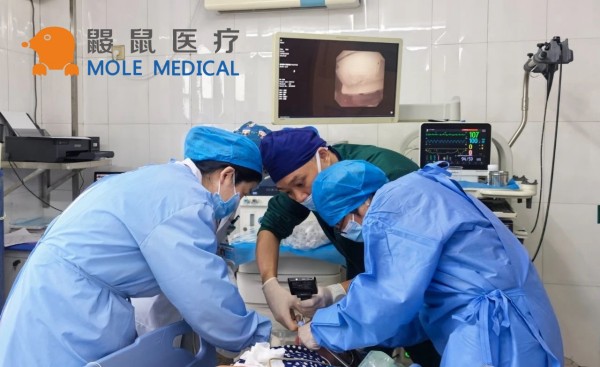Laryngoscope mole Fiber optic: A Clearer View, A Safer Airway
Apr 24, 2025
The Laryngoscope mole Fiber optic is a tool for airway management. It helps doctors see inside the throat. It has a fiber optic system that gives a bright and clear view. Doctors use it to guide breathing tubes into the airway. It makes intubation easier and safer.

This laryngoscope works with different blades. The Miller blade is straight and helps lift the epiglottis. The Macintosh blade is curved and moves the tongue aside. The McCoy blade has a flexible tip for difficult cases. Doctors can choose the right blade for each patient.
A clear view helps doctors place tubes correctly. Poor visibility can cause mistakes. Good lighting and sharp images improve success. The Laryngoscope mole Fiber optic helps doctors work fast and safely. How can better tools improve airway management?
The Need for Enhanced Airway Visualization
Challenges Faced in Intubation and Airway Procedures
Intubation is a critical procedure. It helps patients breathe when they cannot do so on their own. Doctors must place a breathing tube into the airway. This requires a clear view of the throat. In many cases, swelling, obstructions, or difficult anatomy make the process harder. Poor visibility increases the risk of errors. Multiple attempts can injure the patient. A reliable tool is needed for accuracy.
Limitations of Traditional Fiberoptic Scopes
Traditional fiberoptic scopes have been useful for years. They help doctors see inside the airway. However, they have some limits. The image quality is often low. Poor lighting can make visualization difficult. Some scopes are not flexible enough to reach tight spaces. These issues can slow down procedures and cause complications. A better solution is needed to improve safety and success rates.
Innovative Features of Mole Medical‘s Laryngoscope mole Fiber optic
High-Definition Imaging and Real-Time Visualization
Mole Medical’s Laryngoscope mole Fiber optic has a high-quality fiber optic light source. It provides a bright and clear view of the larynx. Doctors can see real-time images with sharp detail. This helps them place breathing tubes more accurately. A well-lit airway reduces mistakes. The improved visibility allows for faster intubation. A clear image is important in emergencies and surgeries.
Flexible, Maneuverable Design for Precise Airway Access
This laryngoscope is designed for easy use. It has a flexible structure that allows smooth movement. Doctors can adjust its position for better access. The device comes in different sizes. It works for both children and adults. The Laryngoscope mole Fiber optic also supports different blade types. Each blade is made for specific airway needs. The design helps doctors perform procedures with more precision.
Improved Patient Safety & Clinical Outcomes
Reduced Trauma Risk
The design of the Laryngoscope mole Fiber optic helps protect the airway. It reduces contact with tissues. This lowers the risk of injury during intubation. A smooth surface and precise control prevent unnecessary pressure. Less force means fewer complications. Patients experience less pain and recover faster.
Minimal Tissue Disruption
The device allows gentle movement inside the throat. It does not press too hard on delicate tissues. The vocal cords and airway stay protected. A clear view helps doctors work with care. The risk of swelling and bleeding is lower. This makes intubation safer and more effective.

Applications Across Medical Specialties
Use in Anesthesiology, Emergency Medicine, and Critical Care
Doctors in many fields use the Laryngoscope mole Fiber optic. Anesthesiologists use it before surgery. It helps them place breathing tubes quickly. Emergency doctors use it for critical patients. It helps secure the airway fast. Critical care teams rely on it in intensive care units. It makes intubation safer in high-risk cases.
Benefits in Difficult Airway Scenarios
Some patients have difficult airways. Swelling, trauma, or unusual anatomy can block the view. A normal laryngoscope may not work well. The Laryngoscope mole Fiber optic gives a clear image even in tough cases. It helps doctors see better and act faster. This improves success rates and reduces complications.
Comparative Advantage Over Traditional Tools
How Laryngoscope mole Fiber optic Stands Out in the Market
- Superior Illumination for Better Visibility
The Laryngoscope mole Fiber optic has a powerful fiber optic light. It provides bright and steady illumination. This helps doctors see the larynx clearly. A well-lit view improves intubation success. It also makes examinations more accurate. Poor lighting can lead to mistakes. The strong light ensures safer procedures.
- Versatility in Blade Options for Different Patients
This device has different blade sizes and styles. It works for infants, children, and adults. Doctors can choose the right blade for each patient. This makes intubation easier. A proper blade ensures better control. The device adapts to different clinical situations. It is useful in many medical settings.
- Durable and Long-Lasting Design
The laryngoscope is made from 316 medical stainless steel. It is strong and lasts a long time. It resists corrosion and wear. The surface is smooth and free of rough edges. The ergonomic handle gives a firm grip. A mesh texture prevents slipping, even when hands sweat. The cold light source has a long service life. The blade and fiber optic can be removed for easy cleaning. These features make it a great investment for hospitals.
Testimonials from Healthcare Professionals
Many doctors trust the Laryngoscope mole Fiber optic for its precision and ease of use.
Dr. James R., Anesthesiologist: “This device has reduced failed intubation attempts in my practice. The clear view makes a huge difference.”
Dr. Sarah M., Critical Care Specialist: “In emergencies, every second counts. The bright illumination and real-time imaging help me act fast and safely.”
Nurse Emily T.: “It is lightweight, easy to clean, and simple to handle. It makes my job much easier.”
Healthcare professionals agree that this tool improves patient care.
Real-World Success Stories & Case Studies
Examples of Improved Patient Outcomes
Hospitals report better success rates with this device. In one case, a patient with airway swelling needed fast intubation. The doctor used the Laryngoscope mole Fiber optic and secured the airway quickly. Another case involved a child with a narrow airway. The device’s small blade helped doctors work safely. These cases show how better tools save lives.
Feedback from Leading Hospitals and Clinicians
Many hospitals now use this laryngoscope. A large medical center found that it reduces complications. A leading anesthesiologist said it helps with difficult airways. A trauma surgeon said it is reliable in critical cases. Clinicians recommend it for its accuracy and ease of use. Hospitals continue to see its benefits in daily practice.
Upgrade Airway Management with Mole Medical’s Laryngoscope mole Fiber optic
Get a clear view for safer intubation. The Laryngoscope mole Fiber optic provides bright illumination and real-time imaging. It helps doctors work fast and accurately. The ergonomic design ensures a secure grip. Different blade sizes fit all patients. It is easy to clean and built to last. Trusted by medical professionals worldwide. Improve patient care with better technology. Choose reliability and precision for every procedure. Upgrade your equipment today. Order now and enhance your airway management!
Categories
Latest Articles

Disposable Nephroscopes: Redefining Safety & Efficiency in Urology
Introduction The shift towards minimally invasive urological surgery has found a pivotal ally: the disposable nephroscope. As traditional reusable scopes grapple with persistent biofilm contamination risks and soaring sterilization costs, the global medical community is rapidly adopting single-use solutions. This article analyzes the clinical value, technological evolution, and dynamic innovation landscape driving this transformative shift. ... Read more

Disposable Video Laryngoscope Blades: The Ultimate Solution for Preventing Cross-Contamination
In the operating room, as the cold light of a video laryngoscope illuminates a patient’s airway, an age-old medical challenge is being redefined: How can life-saving instruments avoid becoming vectors of infection? Jiangsu MoleMedical drives an innovative safety revolution—replacing reusable devices with single-use, sterile laryngoscope blades that create a pure barrier for critical airways. Traditional video ... Read more
-2.jpg)
FDA & CE Approved Video Laryngoscope: What Makes It Stand Out?
Introduction In high-pressure emergencies and precision-driven operating rooms, video laryngoscopy is revolutionizing airway management. Mole Medical’s FDA and CE-certified technology replaces tactile-dependent “blind intubation” with real-time visual navigation – enhancing safety, accuracy, and clinical outcomes worldwide. Why Certification Matters Mole Medical’s dual certifications validate its global compliance and performance: FDA Clearance: Rigorous validation of safety/efficacy ... Read more

Mole Medical Showcases Advanced Endoscopy Solutions at CMEF Autumn 2025, Driving Global Partnerships
Guangzhou, China – September 26-29, 2025 – The 92nd China International Medical Equipment Fair (CMEF Autumn) concluded successfully on September 29th at the Canton Fair Complex in Guangzhou. Mole Medical Technology Co., Ltd. (Mole Medical) made a significant impact at the event, drawing global medical professionals and partners to its booth (Hall 2.1, Stand Q24) ... Read more

How to Use Disposable Ureteroscopes Safely and Efficiently
In the field of urology, the application of disposable electronic ureteral-kidney pelvis endoscopy catheters is leading the technological innovation in minimally invasive surgeries. According to the 2024 multi-center research data from China’s urology department, among the over 5,000 surgeries included, the patient group using disposable catheters performed significantly better in key indicators such as operation ... Read more



